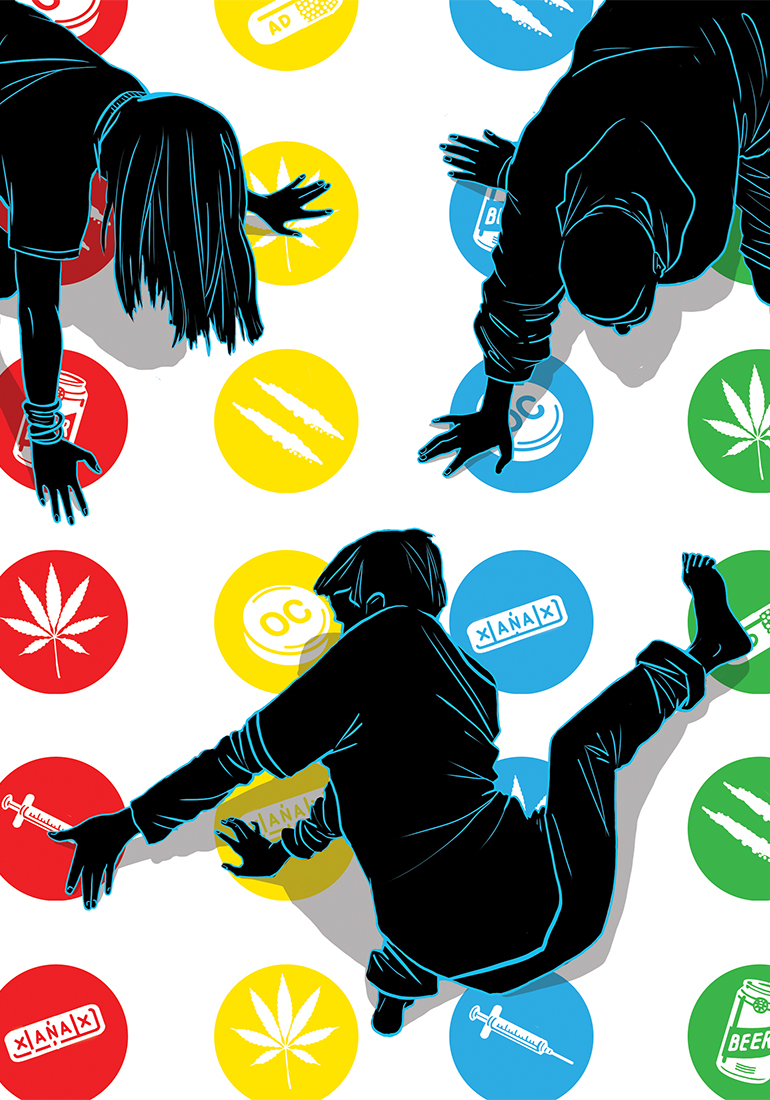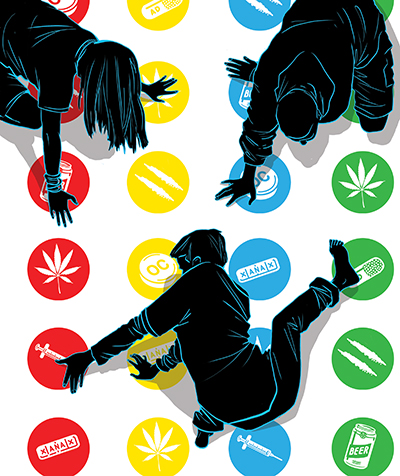 “WE HAVE A SERIOUS PROBLEM ON OUR HANDS AND WE’RE JUST NOT GETTING THROUGH TO PEOPLE.” — MATT WILLIS, MARIN COUNTY PUBLIC HEALTH OFFICER
“WE HAVE A SERIOUS PROBLEM ON OUR HANDS AND WE’RE JUST NOT GETTING THROUGH TO PEOPLE.” — MATT WILLIS, MARIN COUNTY PUBLIC HEALTH OFFICER
MATT WILLIS, MARIN’S chief of public health, is pacing the rug as he ticks off statistics, a frown creasing his forehead. We’d planned this interview to discuss Marin’s high rates of teen drinking and drug abuse, along with efforts by Willis and colleagues around the county to bring those numbers down.
But things had taken a dramatic turn the day before, when news broke about a “party bus” stopped by police near the Larkspur Ferry Terminal with 33 Marin teenagers ages 15–17 aboard, along with jaw-dropping quantities of hard alcohol, marijuana and prescription drugs.
The kids, who hailed from practically every community in Marin, had planned a six-hour joyride to celebrate the first day of summer, a plan initiated by a Tiburon 16-year-old with a $900 cash payment. And although the bus was stopped as it pulled out of the terminal, the trash was already full of empty alcohol containers.
The situation has Willis rattled, and that’s understandable. Since his arrival on the job in 2012, he’s worked exhaustively to raise awareness about the county’s substance abuse problems, creating task forces, launching initiatives, and forging partnerships with schools, community groups and government agencies. And yet clearly the message is not getting through — or at least not to those who need it most.
“This isn’t just about the bus; this is an ongoing public health crisis for us here in Marin. Our numbers for teen drug and alcohol use are way higher than the state average,” Willis says. According to the most recent data from the California Healthy Kids Survey, almost half of all Marin 11th graders and more than a quarter of ninth graders drink or use drugs, while a third of all 11th graders and 10 percent of ninth graders qualify as heavy drug users.
There are more shocking stats, too: over the last 15 years, drug-related ER visits and drug-related deaths in Marin more than tripled. “We had one accidental overdose death every two weeks from 2012 to 2013; that’s about three times as many accidental overdose deaths as car vehicle deaths,” Willis adds.
While the number of fatalities within the county dropped in 2014, deaths are just the tip of the iceberg, he says. “We know that for every overdose death, there are about 1,000 people affected by the problem.” And, says Willis, county data don’t include the young Marinites who die of similar causes while away at college.
“We’ve had too many of these tragedies recently, and the seeds are here; those habits were established during the high school years, and the grief is experienced in our community.” Willis also points out that the data do not include cases in which high schoolers died suddenly without a clear cause of death but drugs — or withdrawal from drugs — may have been a factor.
In fact, if there’s one thing about the party bus incident that has Willis most upset, it’s the deadly risk posed by the simultaneous presence of prescription drugs and hard alcohol. “This is where we see our fatalities,” he says. “Kids are already intoxicated and their decision-making changes. They take a Xanax or two and that’s enough to be fatal.”
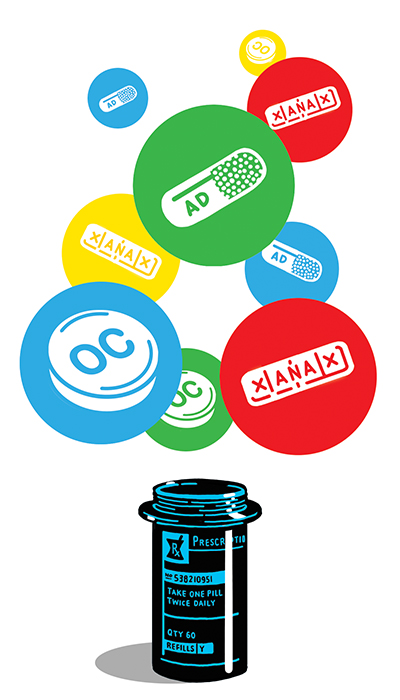 “WE THINK THAT JUST BECAUSE IT COMES FROM A BOTTLE IN OUR MEDICINE CABINET, IT MUST BE SAFE.” — TIMI LESLIE, CO-CHAIR OF RXSAFE MARIN
“WE THINK THAT JUST BECAUSE IT COMES FROM A BOTTLE IN OUR MEDICINE CABINET, IT MUST BE SAFE.” — TIMI LESLIE, CO-CHAIR OF RXSAFE MARIN
A STARTLING 24 PERCENT of all Marin 11th graders and 15 percent of all ninth graders surveyed by California Healthy Kids admit to using prescription drugs recreationally. Even more alarming: 16 percent of 11th graders say they’ve used two or more drugs at the same time.
Indeed, prescription drug abuse is one of Marin’s most pressing issues.
“More than 400,000 prescriptions for painkillers, sedatives and stimulants are written in Marin annually, and we only have 250,000 people total, including kids,” says Timi Leslie of the community coalition RxSafe Marin. “That adds up to about 21 million pills every year being dispensed into our community. So when you talk about availability, it’s really everywhere.”
And Marin is not spared from vulnerability to America’s epidemic of opioid addiction. In the past five years, the number of young adults seeking treatment for opiate abuse in the county has doubled. Nationally, statistics from the Partnership for Drug-Free Kids show that nearly half of young people who inject heroin start by abusing prescription drugs.
“WHAT WE HAVE IS A MAJOR PROBLEM OF PERCEPTION.” — LISA MOLBERT, DIRECTOR OF INTENSIVE OUTPATIENT SERVICES FOR MUIR WOOD ADOLESCENT AND FAMILY SERVICES
MARIN IS A COUNTY famous for high expectations, affluence, and a liberal culture that values independence, dislikes rules and sets a high priority on fun. In other words, it’s many of the factors that make Marin so quintessentially Marin that are fueling the teen drug and alcohol crisis, experts say.
“We allow kids a lot of independence and a lot of freedom here, which sometimes is a good thing,” says David Frankel, Ph.D., a clinical psychologist with a Marin practice who treats many teens. “But that also means a lot of parents don’t know where their kids are much of the time.”
Part of the issue is misguided love, says David Sheff of West Marin, author of Clean and Beautiful Boy, a memoir about his son Nic’s drug addiction. “Parents want their child to be popular and have fun and they don’t want the child to be mad at them so they turn a blind eye to things,” Sheff says.
There’s also a quality in the culture here that leaves many parents reluctant to take on what’s perceived as a traditional “hard line” role, Frankel says. “Some parents are living vicariously through their kids, or they’re trying to be a hip friend rather than a parent. In some cases, a parent is just a big kid himself.”
Willis, who has a daughter at Drake High School, agrees: “There’s a lot of that wanting to be ‘cool Dad,’ here.”
And even when we are concerned, we’re failing to communicate that to our kids, Willis adds. “The data show that 53 percent of kids say that their parents are not highly concerned about substance abuse, yet 90 percent of parents say they’re very concerned. That’s a big disconnect.”
Then there’s the fact that Marin’s adults statistically are shown to do quite a lot of partying themselves, behavior they’re likely modeling for their kids. “Marin has one of the highest rates of adult binge drinking in California, and it’s no accident that there’s a correlation between that and what the kids are doing,” says Lisa Molbert, director of intensive outpatient services for Muir Wood Adolescent and Family Services.
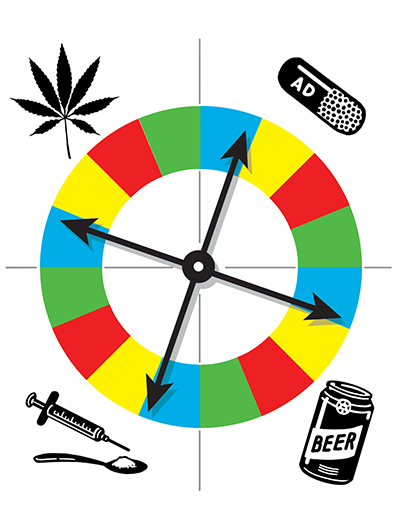 “AT THE TIME, THEY DIDN’T SEEM LIKE BAD CHOICES; THEY FELT LIKE CHOICES THAT WOULD ALLEVIATE THE SUFFERING I WAS FEELING.” — CHARLOTTE LONG, RECOVERING ADDICT
“AT THE TIME, THEY DIDN’T SEEM LIKE BAD CHOICES; THEY FELT LIKE CHOICES THAT WOULD ALLEVIATE THE SUFFERING I WAS FEELING.” — CHARLOTTE LONG, RECOVERING ADDICT
“AT THE BEGINNING, it was very innocent, just having a few beers here and there — this was just the norm in the culture,” says Charlotte Long (not her real name), who was a varsity soccer star and straight-A student when she began drinking and doing drugs in her sophomore year at Redwood High School.
“All my friends were very similar to me, academically driven, gifted in athletics, and fun all-around people, and this is just what we did — someone would say, ‘Let’s bring a keg and some weed up on Mount Tam’ and off we’d go.”
But with the help of a wealthy boyfriend who had easy access to drugs, Long’s use escalated quickly and she became addicted to cocaine. “I was under a ton of pressure from school, my parents, all these extracurriculars, and drugs became my escape and release,” she says.
At UC Santa Cruz, she continued to get straight As — while driving to the Tenderloin as often as four times a week to score drugs. “I graduated in the top 10 percent of my class at UC Santa Cruz and I was a full-blown heroin addict — I lived a totally double life.”
Long wasn’t alone; among her group of high school friends there were numerous near-misses, and one friend died of an OxyContin overdose at UC San Diego just after Christmas break. “There was a lot of loss of life among my group of friends,” Long says. “These were smart kids who came from good families, struggling with addiction and not knowing what to do.”
Long was one of the lucky ones — if you can call it lucky to watch your life unravel, she says. But four and a half years ago, living out of her car and panhandling in the Tenderloin, she asked her family to help her go into treatment.
Today she’s active in drug policy at the county level, eager to help make changes so that what happened to her doesn’t happen to others, with possibly even worse consequences.
“IF WE CAN SAVE ONE OTHER FAMILY FROM GOING THROUGH THIS HELL, IT’S WORTH IT.” — JEANNETTE TORCHON, PARENT WHO LOST A CHILD TO DRUGS
A.J. TORCHON WAS only 19 — a Novato High School graduate just a few months into his sophomore year at UC Santa Barbara — when he died of an accidental painkiller overdose.
Blindsided and anguished, his parents, Ric and Jeannette, made a decision they didn’t even realize was unusual: they put the cause of death in his obituary. “A woman from the paper called me and said, ‘Are you sure you want to say this? People don’t usually want that information in there.’ ”
But the Torchons did, hoping that by being open and honest they could alert other families to the dangers they’d missed.
“When people, especially in affluent communities, think about people dying from drug overdoses, they think of people who are addicted,” says Ric Torchon. “But A.J. wasn’t an addict. Parents don’t realize that a drug overdose can happen the first or second time someone uses a drug.”
“One of the hardest things in this situation is the stigma that’s attached to it,” says Susan Kim of Novato, whose son, Trey Lagomarsino, died of an overdose of prescription cough syrup in 2013 at the age of 23.
“You’re going through this horrible tragedy, and you don’t want the shame of being judged,” she says. “But if we don’t speak about it, if we don’t make the information public, how will anyone else know what’s going on? I raised three boys here in Marin and had no idea what the kids were taking.”
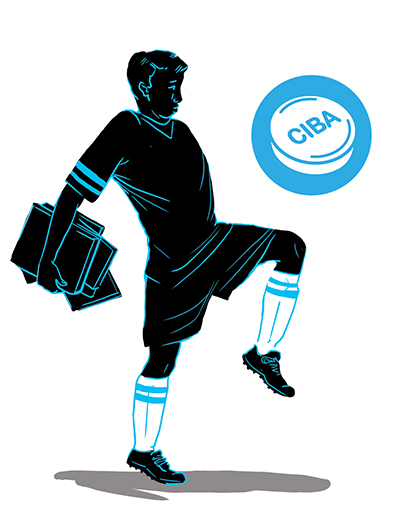 “THE STIGMA IS AS DANGEROUS AS THE DRUGS.” — MARK DALE, FAMILIES FOR SAFER SCHOOLS
“THE STIGMA IS AS DANGEROUS AS THE DRUGS.” — MARK DALE, FAMILIES FOR SAFER SCHOOLS
“NO ONE IS TRACKING the numbers and communicating them to parents,” says Mark Dale of San Rafael, founder of Families for Safer Schools and chair of the Alcohol and Other Drugs Advisory Board for the Marin County Board of Supervisors. “And the silence is killing us.”
Dale should know; he almost lost a son to drug overdose not once but twice, an experience that set him on a mission to get Marin’s schools and communities to begin sharing data on overdoses, ER visits, and other drug- and mental health–related incidents.
“The schools are concerned about their reputations, afraid parents will find out about these incidents and the school will be painted as a drug school,” says Dale, whose son was only in middle school the first time he overdosed. “But every school in Marin has lost kids to prescription drugs or a combination of drugs and alcohol. And we’re not hearing about the size of the problem.”
And how can we expect kids to be brave enough to speak up, asks Dale, if we aren’t?
“Every time a child dies, the parents go to the child’s friends and ask, ‘Did you know he or she was doing this?’ and the answer is always ‘Yes, but we didn’t know how to help and we were afraid of getting him in trouble.’ I’ve seen so many situations where nobody had the courage to tell the parents to get the child help.”
“PARENTS ALWAYS THINK THEY’D KNOW.” — DAVID FRANKEL, CLINICAL PSYCHOLOGIST
EVERY PARENT WANTS to believe he or she’d know right away if a child was getting into trouble, but as Charlotte Long’s story suggests, this is often not the case. “Part of being a drug addict is you have to lie and deceive the people closest to you,” says therapist David Frankel. “I’ve had kids in my practice who are using heroin and lying to me and it’s even taken me a while to figure it out, so I have a lot of sympathy for parents and how hard it can be to spot.”
One strong tip-off, though, is a pattern of untruthfulness or secrecy, he says. “You might see a flurry of little lies, things that don’t add up, and then when you ask about them, you get seemingly nonsensical reasons why the kid’s not telling the truth,” Frankel says.
Other signs to watch for include declining grades, withdrawal from friends, or physical changes like lethargy or gaining or losing weight. But don’t be fooled by the myth that drug use is associated with kids who are “screwups,” says Frankel. “Many kids with drug problems are quite high achieving, and kids who use drugs seriously over time get better at hiding it.”
“KIDS WILL DO ANYTHING TO GET AHEAD, SO IF TAKING A STIMULANT GIVES YOU AN ADVANTAGE, WHY WOULDN’T YOU?” — ANONYMOUS STUDENT
FEW TOPICS CAN turn a room of Marin high school parents tense as quickly as allegations of stimulant abuse. That’s what I heard from a number of parents and kids, reluctant to speak out for fear of angering or betraying friends and peers.
“When parents see their kid, who is brilliant and has always gotten perfect grades, suddenly start struggling in AP calculus, they decide something’s wrong with him and call a doctor, who then feels persuaded to prescribe drugs,” says one parent, echoing comments by dozens more.
“Good parents are being told it’s the right thing to do. It’s not like they’re drug seeking and trying to trick the doctors; it’s the situation, the workload, the expectations, this whole stressed-out equation,” another parent says.
Of course, there are also kids who are getting pills illegally, often from friends selling their own prescriptions. At some high schools, the use of ADD meds as study aids is so widespread that kids who choose not to use them actually feel at a disadvantage, some students told me. “I am quite literally the only person I know my age who got through high school and college without trying Adderall, and that is not an exaggeration,” says one Tam High grad.
The trend has become pronounced enough that this spring Partnership for Drug-Free Kids released a short documentary, Breaking Points, highlighting the ways teens use stimulants to cope with stress and pressure and offering healthier solutions.
This phenomenon has serious consequences for kids with legitimate learning disabilities, for whom the medications are intended to help level the playing field. If already high-achieving kids are also taking these medications, then it negates the benefit for the kids who actually need it, say several parents disturbed by the situation.
Many parents also mistakenly believe so-called “smart drugs” aren’t addictive, says Sheff. “I meet kids in treatment all the time who took Adderall to help with school, then couldn’t stop. They go through withdrawal and get super anxious, and then they either start taking it again or they take something else to calm down.”
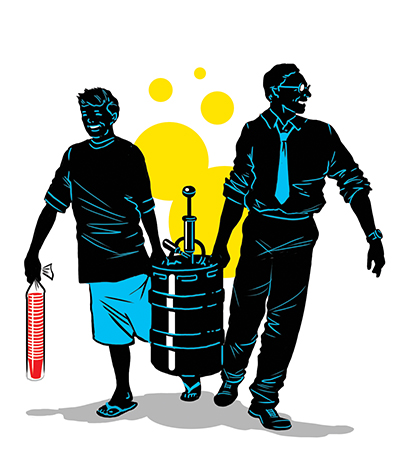 “TEENS NEED TO HEAR THAT THIS IS A BIG DEAL.” — MARY JANE BURKE, SUPERINTENDENT OF SCHOOLS
“TEENS NEED TO HEAR THAT THIS IS A BIG DEAL.” — MARY JANE BURKE, SUPERINTENDENT OF SCHOOLS
THERE’S NO QUESTION that for many of those interviewed for this story, the summer party bus incident was a dispiriting sign that Marin has a long way to go to get a handle on the teen drug crisis. But it is also putting the topic on the table in a big way, Matt Willis says.
“Sadly, for many of us who do this work, incidents like this party bus [discovery] don’t come as a surprise anymore,” says Willis. “We already know this is a huge issue. But thankfully tragedy was averted this time, and at least now we can use this as a catalyst for important conversations.”
In August, a town hall meeting brought together public health officials, the school districts, and numerous task forces to discuss the party bus incident and look at next steps to prevent another such situation. “We hope this will be the beginning of putting together an overall strategy of safety,” says Mary Jane Burke, superintendent of schools.
Last January, Redwood High opened an on-campus Wellness Center, providing substance abuse counseling and education, sexual health services, and mental health support on both a drop-in and an appointment basis. The response was even better than expected, says Wellness Center director Jessica Colvin. “We had between 50 and 200 students a day dropping in, and we saw several hundred individually.” A second wellness center is opening at Drake this fall, and Tam will have one come January.
Perhaps the biggest effects may stem from a school-based initiative known as “Be the Influence,” which focuses on uniting parents in a shared effort to hold the line on partying and abuse.
Parents who sign up to participate get access to contact info for other parents, making it possible to confirm a child’s whereabouts, ascertain there will be adult supervision at a party and in general check in about what’s going on in the teens’ social world.
“What it does is create a culture in which parents don’t feel so isolated and alone,” says Linda Henn, program coordinator for Twin Cities Coalition for Healthy Youth. A similar program, Be the Influence, started at Redwood, then spread to Tam and Drake and on to Branson, Marin Catholic and San Domenico. “So often parents feel like they’re the only ones saying no, and you start feeling like you’re going crazy; no parent wants to be the bad guy when everyone else is giving in.”
Other efforts center around educating parents in ways to hold the line more firmly, says Burke. “It’s [parents’] job to set limits and provide boundaries and consequences, whether that makes us popular or not.”
And while kids may kick and scream over limits, they’re often secretly relieved to be able to blame parents for preventing them from doing something they weren’t entirely comfortable with. “My daughter tells me now that what helped her decision-making more than anything else was having her ‘mean mom’ to provide her the cover to say no. But we have to give them that opportunity to blame us.”
And if you think your child is in trouble? “One of the most helpful things a doctor once said to me was, ‘If you think there’s a problem, there’s a problem,’ and I’ve found that to be true for so many kids,” says Sheff. “Trust your gut.”
FOR MORE INFORMATION
These organizations offer information and support to educate parents and teens about drug abuse prevention and treatment.
FAMILY SERVICE AGENCY OF MARIN A division of Buckelew Programs, FSA offers a host of behavioral health services for teens and families. 415.491.5700, fsamarin.org
KAISER PERMANENTE SAN RAFAEL CHEMICAL DEPENDENCY SERVICES Individual and group treatment and support groups for Kaiser members. Walk-in hours Monday–Friday 9 a.m.–3 p.m. 415.491.3000
MARIN COUNTY BEHAVIORAL HEALTH AND RECOVERY SERVICES The mental health and addiction arm of Marin Health and Human Services, BHRS offers prevention, intervention and treatment services. 888.818.1115, marinhhs.org/behavioral-health-recovery-services
MUIR WOOD ADOLESCENT AND FAMILY SERVICES A private drug and alcohol treatment program with outpatient programs for boys and girls in San Rafael and an inpatient program for boys in Sonoma. 855.300.1720, muirwoodteen.com
NIDA FOR TEENS The National Institute on Drug Abuse (NIDA) produces effective fact-based educational materials for teens, including the PEERx program on prescription drugs. teens.drugabuse.gov, teens.drugabuse.gov/peerx
NOVATO BLUE RIBBON COALITION FOR HEALTHY YOUTH novatoblueribbon.org
PARTNERSHIP FOR DRUG-FREE KIDS A national organization providing resources, education and referrals as well as the documentary Breaking Points, available for individual rental and community showings. drugfree.org
RxSAFE MARIN A coalition of community members and experts working to prevent prescription drug misuse, abuse and addiction. rxsafemarin.org
SAN RAFAEL ALCOHOL COMPLIANCE TEAM (ACT) A cooperative program run by San Rafael and Terra Linda high schools and the SRPD to prevent teenage drinking and drug use. facebook.com/sanrafaelact
REDWOOD HIGH SCHOOL WELLNESS CENTER An on-campus counseling center offering confidential supportive services for students struggling with substance-related concerns as well as stress, anxiety and depression, sexual health issues, family conflicts, and more. 415.945.3663, tamdistrict.org/rhs_wellness
REDWOOD HS BE THE INFLUENCE redwoodptsa.org/be-the-influence
DRAKE HS BE THE INFLUENCE tamdistrict.org/Page/8878
TAMALPAIS HS BE THE INFLUENCE tamdistrict.org/Page/9403
TWIN CITIES COALITION FOR HEALTHY YOUTH thecoalitionconnection.com
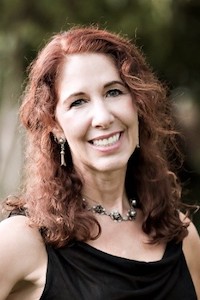
Melanie Haiken is a writer, editor and web project manager based in the San Francisco Bay Area. She operates on two simple assumptions: Everyone has a story to tell. And a story well-told will always find an audience. Her work is characterized by exceptional clarity, depth and insight – no matter the topic covered. Haiken writes for AFAR, Forbes, Via, Yoga Journal and many other national magazines and websites. She has also created award-winning marketing and custom publishing materials and communications campaigns for clients like Adobe, Wells Fargo, Lane Bryant, Kaiser Permanente and Safeway.

